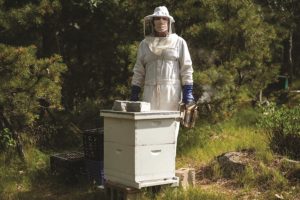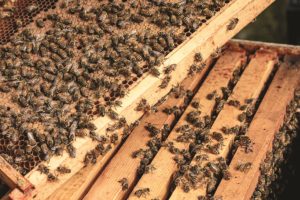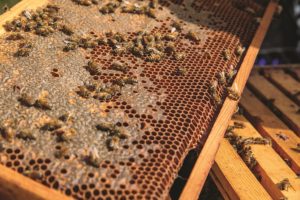Deep into summer, beekeeping on the Outer Cape is mostly a waiting game. The queen has been laying since April; the hive population is perhaps 60,000. Though we’re in a dearth — there’s not much nectar around — the bees have stores of honey, and clusters of clethra buds are standing tall. If we get the rain we need, they will bloom soon and, in another six weeks, a late summer harvest will be possible.
But even in a small apiary, there are always challenges to be managed. The two hives in Barbara Brennessel’s Wellfleet bee yard are stacked only two boxes high. Both colonies that she and her husband, Nick Picariello, are tending are small for this time of year. That’s because their bees didn’t winter over. (Lots of different things can go wrong.) They removed the “deadouts” and started over in late spring with small, new nucleus colonies.
If you’re interested in beekeeping, now is a good time to learn and observe. Offer to help a friend with the harvest and you might end up inspired to set up your own apiary next spring. A walk around Barbara’s and Nick’s bee yard is a good orientation. —Teresa Parker

Hives are set up facing southeast, for early morning light, tucked at the back edge of the yard against the woods, so they’re in dappled shade on a hot afternoon. They need a birdbath nearby for water, too. Bees don’t need a lot of space, but they do need take-off and landing room in front of the hive. The vegetable garden is off to the side to keep gardeners from being right on the bees’ flight path. “The neighbors say, ‘Your bees were over here today,’ and that may be, but honey bees will travel a good distance — two or three miles —to forage,” says Brennessel. “It’s important to check in with your neighbors and make sure they’re comfortable with your having bees nearby.” Honey is the proper thank you.

These boxes are “deeps” — 14 3/4 by 18 3/8 by 9 5/8 inches — that get stacked as the colony grows and needs more space. Note the front porch, where bees come in for a landing. On a mature colony, the entrance would be open wider in summer, but for a newish colony like this one the narrower entrance provides better defense against robber bees. Yes, other bees do that when a colony is weak. Stones weight the cover so it won’t blow off in a storm.

A few puffs of pine needle and oak leaf smoke mask alarm pheromones and sends the bees down into the hive. While the bees gorge, Brennessel and Picariello go to work pulling out individual frames — 10 fit in each deep — to see how things are going in the hive. A thin sheet of beeswax “foundation” is set in each frame to start the bees drawing out their neat hexagonal-patterned comb. This whole easy-to-inspect set up, a Langstroth hive, is named after its inventor and has evolved only a little since it was patented in 1852. Veils — these are essential — keep bees away from beekeepers’ faces and hair. Honey bees are usually docile and not everyone wears gloves or the suit, though they do protect from stings. This year, Picariello added a mask to his outfit.

Barbara notes their queen is laying. She points out larvae, but mostly capped brood fills the comb in this frame. If you stand still for a couple of minutes holding a frame like this, you will almost certainly see some baby bees emerge. A tiny hexagon of capping cracks open and a new bee pokes its head through, then crawls out.

In this frame, the bees have stored nectar, evaporated it into honey, and capped it with wax — except in the center area, empty now because brood has recently emerged.
![]()
Most of what beekeepers do every week when they check on their hives is to notice these basics: Is there brood? Is there honey? Notes help track progress and problems. On this wooden stirring stick are records on the queen that show how quickly things develop in a new hive: 6-9 9-d QC translates as “On 6-9 we installed a 9-day-old queen cell”; 6-13 NH, normal hatch, the queen emerged; 6-20 MQ, mated queen: she’s been on her mating flight and is now filling out but no eggs seen yet; 6-22 LQ, laying queen, eggs are seen.



